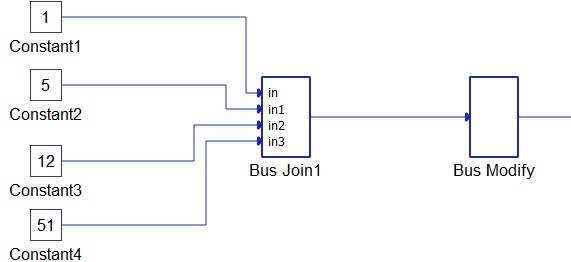Bus Modify
Description of the Bus Modify component in Schematic Editor, which changes one (or more) elements in the input vector and outputs a modified vector signal.
Component Icon

Description
This component is able to change one (or more) elements in the vector. The output is a new/modified vector.
The function of the component is illustrated in Figure 2. The input signal for the component is a vector concatenated of four constant signals (Bus Join in[0], Bus Join in[1], Bus Join in[2], Bus Join in[3]). The output signal is a modified vector signal.

For example, setting the Signal indexes property to [0, 3] and New values to [10, 30], the output vector will have modified values on positions [0, 3] (out[0] = 10, and out[3] = 30).
Ports
- in
-
Input signal connected to the input terminal of the component.
- Supported types: uint, int, real.
- Vector support: yes
-
- out
-
Depending on the value of the Signal indexes and New values properties, a corresponding output vector is created.
- Supported types: uint, int, real.
- The output type is inherited from the input signal.
- Vector support: yes
- Supported types: uint, int, real.
-
Properties
- Signal indexes
-
Type in the list of input signal indexes representing the positions of the elements whose values you want to change. Indexes must be in a list [index1, index2,....] and consist of non-negative integers.
- Indexes must be arranged in ascending order (index1 <i ndex2 < index3...).
-
- New values
- Type in the new values of the elements at the positions defined by the Signal indexes property.
- The new values must be in a list [val1,val2,....] and consist of real/integer numbers.
- The values must be listed in the correct order corresponding to their indexes in the Signal indexes property.
- Execution rate
- Type in the desired signal processing execution rate. This value must be compatible with other signal processing components of the same circuit: the value must be a multiple of the fastest execution rate in the circuit. There can be up to four different execution rates. To specify the execution rate, you can use either decimal (e.g. 0.001) or exponential values (e.g. 1e-3) in seconds. Alternatively, you can type in ‘inherit’ in which case the component will be assigned execution rate based on the execution rate of the components it is receiving input from.